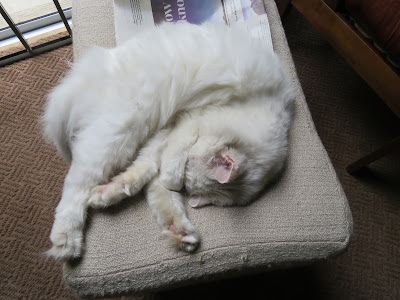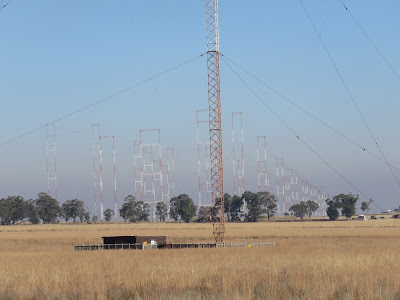Tackled this monster as another boredom reliever with about 400 of the 1000 pieces being Kgalgadi sand.
It's over 30 years since I last experienced a highveld winter and while the days are usually sunny as soon as it sets the shivering starts, so I was quite surprised to get a shot of the sickle moon that's mostly in focus.
Another resident is Spats, who is of the opinion that the only reason for the existence of humans is to play ball with him. The task is normally undertaken by my sister or brother-in-law, but he sometimes looks so pitiful.....
In the small garden in front of my cottage is a plant which suddenly burst into flower just as winter began to bite. A succulent of the cotyledon persuasion, it had never before bloomed and despite industrious searching remains unidentified. Any ideas?
Using a method that was researched and tested at an off campus facility called University of the Witwatersrand Technology Centre, a colleague of mine did his PhD on hydraulic conveying which is the process being used here. A high pressure pump blasts material into a coffer dam and from there .............
..................it is piped to the refinery about 30 km away and the water is recovered, pumped back and reused.
Being in stage 3 of lock-down allows a bit more freedom so I took a drive to visit the aforementioned UWTEC, where I ran a small research facility sponsored Des Bolton who owned Cargo Carriers, a giant in the transport industry. The nearby Sandton skyline has certainly changed dramatically in the intervening years and is beginning to rival Jo'burg. Unfortunately the same can't be said for UWTEC, rather sad.
Not far from here near Heidelburg is the Suikerbosrand Nature Reserve and though currently closed, animals may be seen from the road that runs behind the reserve. Having been starved of animal sightings for many months, it was great to see black wildebeest, zebra, red hartebeest and springbok. The area is also home to a massive Sentech facility which consists of a forest of pylons plus an enormous tower which broadcast radio signals all over the Gauteng region.
Also took the opportunity to get back to birding and complete a couple of Atlas cards, the most abundant species being the avian locusts called red-billed quelea. This is a small flock of about a thousand birds which were feeding in a harvested field..........
.........................then decided to take a perch. It is probably the most abundant bird species on earth and about 100 million birds are eradicated annually in an attempt to reduce their impact on crops.
Back on the road past Suikerbosrand, the Traveller's Joy Clematis aristata was bursting with fluffy seeds and the contrasting colours of grass a delighted..............
.........while a large troop of baboons was returning to the reserve after foraging on nearby farms.
A few days later I headed down to the Vaal Dam on a hazy day and took this looking back at the Suikerbosrand, the ridge to the left being the highest point in Gauteng.
It's that time of year when fires abound and amazingly, the burnt areas attract numbers of birds - presumably feeding on charred insects. Lark species are generally rather drab and difficult to identify, except for this little fellow whose reddish head and smart epaulets make it a red-capped lark.
While trying to photograph a lapwing I got a little too close for comfort to this young black-headed heron who started wriggling his whole body nervously. All that was missing was the hula hoop.
The Vaal Dam contains the Reefs main water supply and covers an enormous area but is not very deep.
Outflow is carefully matched to inflow in order to keep downstream users happy.......
............and the village of Denysville near the wall has plenty of facilities to cater for all types of water sports and fishing - when allowed.
Did a loop back through Vereeniging and passed this power station which was built expressly for Sasol's coal to oil plant. Guess which way the wind is blowing!
A whole field of fluffy headed grasses caught the sun and the eye.
A few days later it was off to Magaliesberg and the irony of this sign really tickled me.
Just after the dorp of Magaliesberg, the Magalies River cuts through a rocky ridge and this provided the opportunity to really get back to nature once more and do some serious birding, though there's not a lot around at this time of year.


























No comments:
Post a Comment